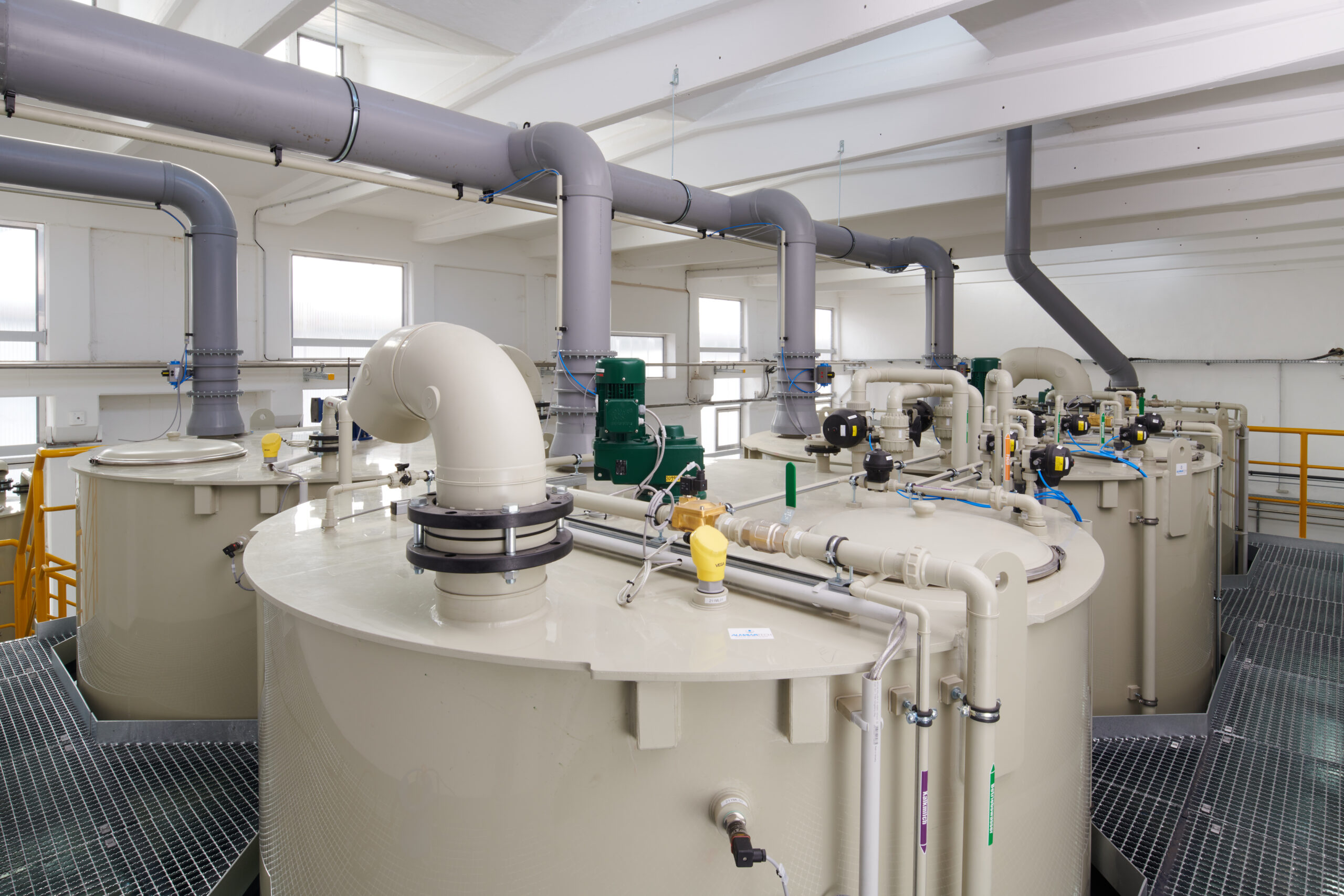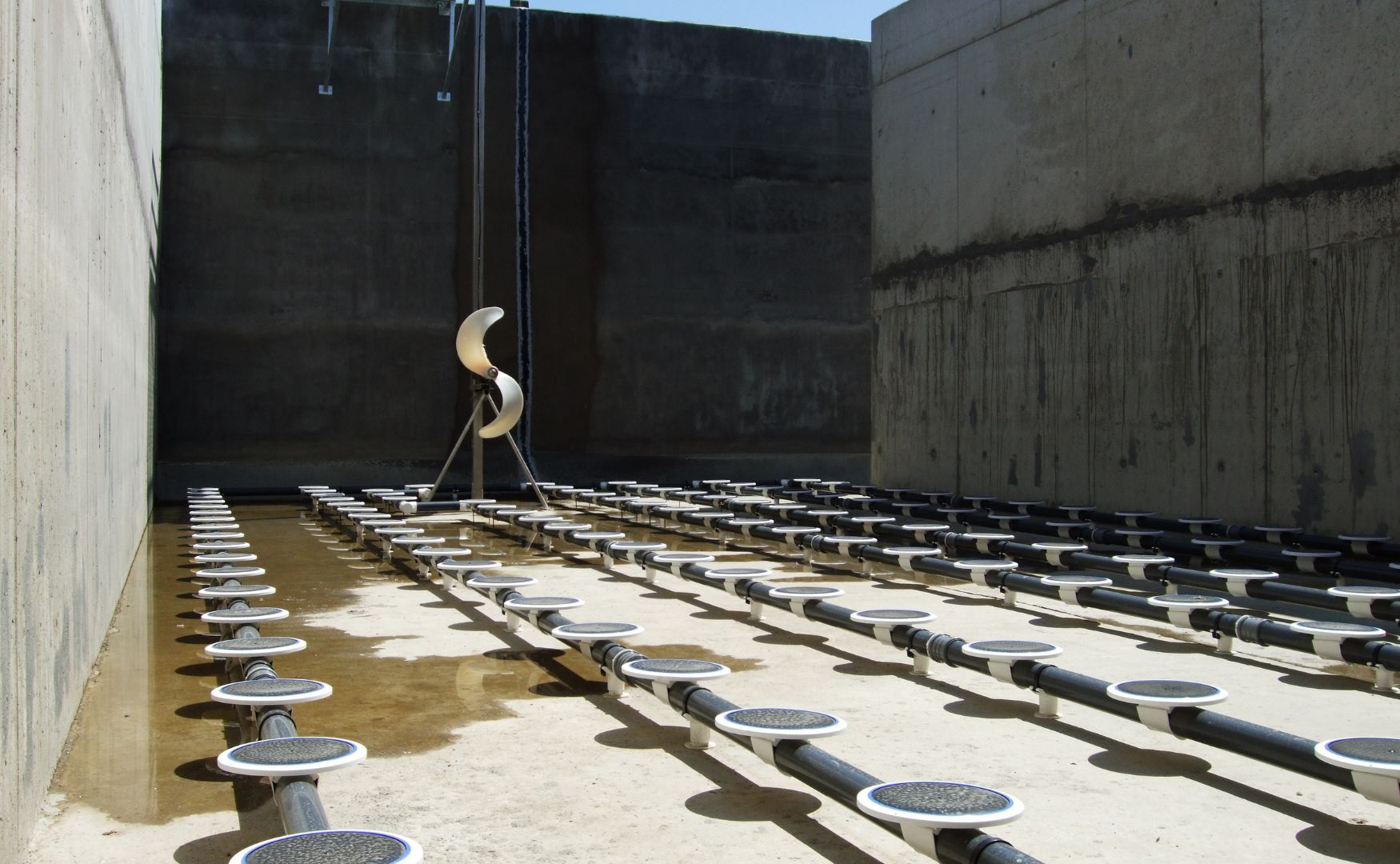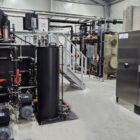An agitator is a mechanical device used to mix liquids, suspensions or emulsions in various industrial applications. In water and wastewater technology, agitators are an indispensable part of many processes, especially in the precipitation and flocculation of pollutants in CP plants, in neutralization plants and in biological wastewater treatment plants for the homogenization of biomass and nutrients. They are used to create homogeneous conditions in the reactor, promote chemical reactions and ensure process stability.
Table of contents
Basics and function of an agitator
An agitator typically consists of the following components:
- Agitator motor: Drives the agitator, usually via a direct or indirect coupling.
- Shaft: Transmits the rotary motion from the motor to the agitator.
- Agitator (propeller, disk or armature): The part that is in direct contact with the medium and generates the mixing.
- Bearings and seals: Ensure the stability of the shaft and prevent the escape of liquids.
Functional principle
The agitator rotates at a defined speed in the medium. The generated movement conveys:
- Homogenization: Uniform distribution of solids, gases or chemicals in the medium.
- Heat exchange: Improvement of temperature equalization in thermally controlled processes.
- Avoidance of deposits: Ensure that particles remain in suspension and do not settle.
The efficiency of an agitator depends on the agitating speed, the shape and size of the agitating element and the physical properties of the medium (e.g. viscosity, density).
Applications of agitators in water and wastewater technology
1. precipitation and flocculation in CP plants
Agitators are used in precipitation and flocculation plants to:
- Evenly distribute precipitants (e.g. iron or aluminum salts).
- To promote the formation of flocs, which can be removed by subsequent sedimentation or flotation.
- Adjust shear forces to optimize flake formation and prevent flakes from disintegrating.
2. neutralization systems
When neutralizing acidic or alkaline wastewater, the agitator ensures rapid and homogeneous mixing of neutralization agents (e.g. sulphuric acid, caustic soda) and the wastewater in order to achieve a uniform pH value.

Photo: Our batch reactors with geared agitators (green) installed on the tank roof (process: CP system ALMA CHEM MCW)
3. biological wastewater treatment
In biological reactors such as activated sludge tanks or anaerobic digesters, agitators convey water:
- The even distribution of nutrients, microorganisms and oxygen.
- Maintaining a stable temperature in the reactor.
- Avoiding sedimentation or the formation of dead zones that could impair the efficiency of the biological process.
4. chemical reactors and dosing systems
In chemical reactors, agitators are used to effectively mix reactants (e.g. antiscalants, precipitants) and accelerate chemical reactions. In dosing tanks, agitators ensure that chemicals are available in a uniform concentration.
5. sludge treatment
In sludge dewatering and treatment (e.g. digestion), agitators are used to ensure the suspension of solids and maximize reaction efficiency.

Photo: Submersible agitator for homogenization of biomass and nutrients, as well as flow and aeration optimization (process: ALMA BHU BIO)
Types of agitators
The choice of a suitable agitator depends on the requirements of the process, the viscosity of the medium and the tank geometry. The most common types are
1. propeller agitator
- Application: For low-viscosity liquids such as water or waste water.
- Advantages: High throughput, low energy consumption.
- Typical application: Precipitation and flocculation reactors, activated sludge tanks.
2. anchor agitator
- Application: For highly viscous media and liquids with a tendency to deposit.
- Advantages: Effective wall wiping, prevents deposits.
- Typical application: Chemical reactors with high solids concentration.
3. disk agitator (Rushton turbine)
- Application: For gas-liquid systems or reactions with high energy requirements.
- Advantages: Effective mixing of gases in liquids.
- Typical application: Biological reactors, gas scrubbing.
4. paddle agitator
- Application: For liquids with medium to high viscosity.
- Advantages: Gentle mixing, suitable for sensitive media.
- Typical application: Sludge equalization tank.
Technical aspects and dimensioning
The selection and dimensioning of an agitator is a complex process based on various parameters:
1. stirring speed
The speed of the agitator must be selected so that the desired mixing quality is achieved without putting too much strain on the medium (e.g. damage to flakes or microorganisms).
2. stirring performance
The power of the agitator depends on the tank size, the viscosity of the medium and the agitator geometry. A typical value is in the range of 1-10 W/m³.
3. container geometry
- Cylindrical containers: Ideal for vertical agitators.
- Rectangular tanks: Often require several agitators or special flow breakers.
- Flow breakers: Prevent the medium from rotating and improve the efficiency of mixing.
4. materials
The choice of material for agitators depends on the chemical aggressiveness of the medium. Frequently used materials are
- Stainless steel (e.g. 316L): Resistant to many acids and alkalis.
- Plastics (e.g. PVDF, PTFE): For highly corrosive media.
- Rubber coatings: Protection against abrasive wear.
Automation and control of agitators
Modern agitators are often integrated into automation and control systems in order to optimize energy consumption and improve process control:
- Speed control: Frequency inverters allow the agitator speed to be adapted to the process requirements.
- Sensor integration: Agitators can be coupled with pH, redox or turbidity sensors to monitor the efficiency of mixing in real time.
- Energy optimization: Load-dependent controls minimize energy consumption, especially in processes with changing requirements.
Advantages of an efficient agitator
- Homogeneous conditions: Optimization of reaction and treatment processes through uniform distribution of chemicals and particles.
- Improved process control: Precise control of chemical and biological processes.
- Prevention of deposits: Prevents the formation of dead zones and sediment in the tank.
- Energy efficiency: Modern agitator designs minimize energy consumption.
Conclusion
Agitators are essential components in industrial water and wastewater technology. They ensure the mixing of media, the stability of processes and an increase in reaction efficiency. Careful dimensioning and selection of the right type of agitator, adapted to the specific process requirements, is crucial for efficient and economical operation. In combination with modern automation and control systems, agitators ensure optimum process control and make a significant contribution to improving water treatment and wastewater treatment.
For further information on our products, please feel free to contact us at any time!








